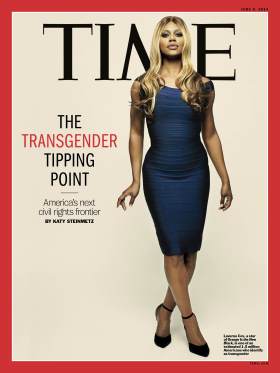The Transgender Tipping Point
< < Go Back
Katy Steinmetz,
Nearly a year after the Supreme Court legalized same-sex marriage, another social movement is poised to challenge deeply held cultural beliefs.
During their long fight to legalize gay marriage, advocates found that their most powerful tool of persuasion was gay and lesbian people themselves. As America got to know the two dads or two moms who live next door, it became easier to see them as a set of neighbors like any other.
Though the numbers are far from concrete, there are an estimated 1.5 million transgender people living in the U.S., about 0.5% of the population. (Put together, LGBT Americans make up an estimated 5%.) That sliver of the population and their supporters will be fighting this battle on two fronts: one is winning hearts and minds, convincing those who are confused or dubious about them that trans identities are just as valid as everyone else’s. If they can succeed there, it will be much easier to achieve policy changes in schools, workplaces, hospitals, the military and other aspects of American life.
The concept of being transgender can be confusing for many people. Though there are few definitions on which everyone agrees, the basic concept is that sex is something determined by biology, while gender is entirely separate, a set of behaviors and expectations developed through human interaction. For many trans people, their gender identity — the way they feel they should fit into society — does not align with the sex that the doctor proclaimed in the delivery room.
Ask anyone who has been working in the transgender movement whether things suddenly seem different today and they will likely say yes. For decades, activists have tried to advance the cause of a misunderstood and oft-caricatured minority. Now, a wave of prominent trans people like Laverne Cox, Janet Mock, Chaz Bono and Chelsea Manning are increasing the visibility of the movement and increasing awareness about trans people among all Americans.
Laverne Cox, on the cover, grew up in Mobile, Ala., a town where she recalls everybody being in everybody else’s business. In third grade, after a teacher saw Cox flitting a handheld fan like Scarlett O’Hara, she called Cox’s mother with a message: your son is going to end up in New Orleans wearing a dress. That moment, Cox says, was “profoundly shaming.” Cox later attempted suicide in sixth grade. Her lonely youth started to change when she went to an arts academy for high school and then on to New York City, where she became an actor, landing a featured role in Netflix’s hit Orange Is the New Black.
Visibility is, in turn, helping to get transgender-friendly laws passed, like a non-discrimination measure signed by Maryland Gov. Martin O’Malley on May 15. It’s also introducing young trans people to more examples of how they can lead their lives in an affirming way, far from the sexualized, miserable figures that have long been easy fodder for the media. Supported by robust communities on the Internet, this new generation is growing up knowing tolerance previous generations could only dream of—even though as a demographic, trans people are remain subject to much higher rates of poverty, harassment, unemployment and suicide than the general population.
“Some folks, they just don’t understand,” Cox tells TIME. “And they need to get to know us as human beings. Others are just going to be opposed to us forever. But I do believe in the humanity of people and in people’s capacity to love and to change.”
In the fall of 2013, Cassidy Lynn Campbell’s classmates elected her homecoming queen of their Huntington Beach, Calif. high school. The selection of a transgender girl for the honor was particularly striking in a traditionally conservative town, and it was celebrated by many as a tolerance milestone. But, amid the cheers were plenty of sneers, including from some of Campbell’s peers, and she posted a teary-eyed confessional video on YouTube the night of her election in which she talked about the pain of being trans.
After coming out to his family at the beginning of sophomore year at Manteca High School, Ashton Lee started collecting signatures to support a California bill that would ensure his right to use the boys’ bathroom and play on boys’ sports teams at his school. The measure, the first of its kind in the U.S., was signed into law by Gov. Jerry Brown in 2013. “People used to shove me in the hallways and call me names,” he says. But that’s changed with the new law. “People have been standing down and backing off,” he says, “because they know they’ll get in trouble.”
1 in 4 transgender Americans say they have lost a job because of gender status.
65% of Americans have a close friend or relative who is gay; 9% have one who is trans.
At women’s colleges, administrators are struggling with how to handle applications from trans women. An even larger question looms over the military, where perhaps as many as 15,500 transgender troops await the day when they can serve openly. On May 15th, Defense Secretary, Chuck Hagel, offered a spark of hope when he said that the policy prohibiting their service “continually should be reviewed”.
And then how do gender markers change on official documents like driver’s license, birth certificates and passports.
More From TIME Magazine:




